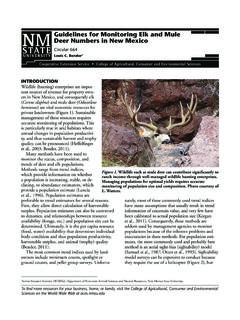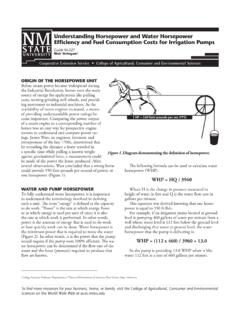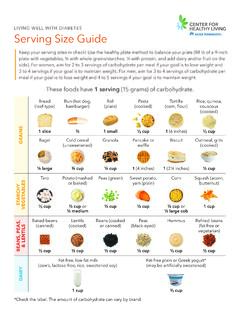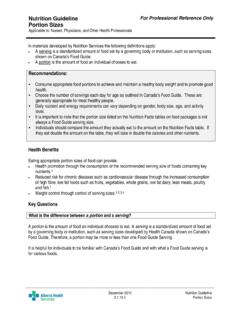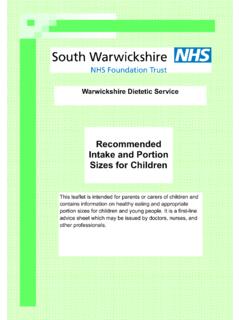Transcription of Diabetes Food Guide Pyramid NUTRITION SERIES
1 The Diabetes food Guide Pyramid is a tool that shows how much you should eat each day from each food group for a healthy diet. The Diabetes food Guide Pyramid differs from the old USDA food Guide Pyramid and from USDA s new MyPyramid. Until MyPyra-mid is modified for use by people with Diabetes , the Diabetes food Guide Pyramid is the best food Guide for people with diabe-tes. The Diabetes food Guide Pyramid places starchy vegetables such as peas, corn, potatoes, sweet potatoes, winter squash, and beans at the bottom of the Pyramid , with grains. These foods are similar in carbohydrate content to grains. Cheese is in the Meat and Others group instead of the Milk group because cheese has little carbohydrate content and is similar in protein and fat con-tent to meat. Choosing foods from the Diabetes food Guide Pyramid can help you get the nutrients you need while keeping your blood glucose under control.
2 The Diabetes food Guide Pyramid places starchy vegetables at the bottom of the Pyramid , with grains. These foods are similar in carbohy-drate content to grains. The Diabetes food Guide Pyramid puts cheese is in the Meat and Oth-ers group instead of the Milk group because cheese has little carbohy-drate and is similar in protein and fat content to meat. Knowing the serving size of high-carbohydrate foods, and choosing the right number of servings per meal, can help you manage your blood glucose. One slice of bread or one starchy vegetable serving fits in the palm of a woman s hand. One fruit serving is about the size of a tennis ball or small fist. One milk serving is 8 ounces, about the size of a small coffee 631 EKaren Halderson, MPH, RD, LD, CDEE xtension Diabetes CoordinatorMartha Archuleta, PhD, RD Extension food and NUTRITION Specialist College of Agriculture and Home EconomicsCooperative Extension ServiceNUTRITION SERIESD iabetes food Guide Pyramid .
3 Reprinted with permission from the Ameri-can Diabetes Association from Diabetes Meal Planning Made Easy by Hope S. Warshaw food Guide PyramidCircular 631 E Page Grains, Beans and Starchy Vegetables Group (6 or more servings a day) Grains1 corn tortilla 1/2 flour tortilla 1/2 piece fry bread 1 slice bread 1/4 bagel 1/2 English muffin 1/2 hamburger bun or hotdog bun 6 crackers 1 4-inch waffle 1 2-inch biscuit 1 2-inch corn bread 1 4-inch pancake 3/4 c. dry cereal (flakes or puffs) 1/4 c. Grape Nuts 1/4 c. granola 1/2 c. cooked cereal (oatmeal, Malt-O-Meal, corn mush, Cream of Wheat) 1/3 c. cooked pasta 1/3 c. stuffing 1/3 c. cooked rice 1/4 c. sweet rice 3 c. popcorn Beans1/2 c. pinto, black, kidney or other cooked dry beans 1/2 c. cooked lentils 1/2 c. cooked split peas Starchy Vegetables1/2 c.
4 Posole 1/2 c. corn 1/2 c. peas 1 small potato 16 french fries 1/2 c. yam or sweet potato 1 c. winter squash (acorn, butternut, buttercup, hubbard) 1 c. pumpkinMilk Group (2 3 servings a day)1 c. milk (cow s or goat s) 1 c. no-sugar-added yogurt 3 oz. fruit-flavored yogurt 1 c. rice milk (unsweetened) 1/2 c. evaporated milk 1/3 c. nonfat dry milk 1 c. plain soy milkTable 1. Foods High in CarbohydratesFruits Group (2 4 servings a day)1 small apple 1/2 large banana 1/2 grapefruit 1 kiwi, pear or peach 1 small orange, nectarine, or tangerine 1 c. melon (cantaloupe) 1 c. papaya 1 1/4 c. watermelon 3/4 c. blueberries or blackberries 1 c. raspberries 1 c. unsweetened strawberries, frozen 3/4 c. fresh pineapple 1 c. mango 1/2 c. canned fruit (peaches, pears, apricots, pineapple, plums, fruit cocktail) or juice 1/2 c.
5 Applesauce 4 fresh apricots 8 halves dried apricot 12 cherries 3 dates 15 grapes 2 small plums 3 dried prunes 2 tbsp. raisinsSweets Group (just a little)1 tbsp. jam or jelly 1 tbsp. honey 1 tbsp. syrup 1 tbsp. sugar 1/2 c. ice cream 1 2-inch piece of cake or brownie (no frosting) 1 small cupcake or muffin 3 graham cracker squares 1 sandwich cookie 3 ginger snaps 5 vanilla wafers 1 Fig Newton 1 Rice Krispie bar 1 rice or popcorn cakeCircular 631 E Page 3 Vegetables Group (3 5 servings a day)1 c. lettuce 1 c. raw spinach or raw greens 1/2 c. cooked spinach, quelites or greens 1/2 c. cooked cabbage or cabbage slaw 1/2 c. cooked brussels sprouts 1 c. raw celery 1 c. raw jicama 1/2 c. salsa 1 green chile 1/2 c. green chile, diced 1/2 c. red chile sauce 1 c. raw green pepper strips 1 c.
6 Raw broccoli 1/2 c. cooked broccoli 1/2 c. cooked beets 1/2 c. cooked asparagus 1/2 c. cooked green beans 1 c. raw onion slices 1/2 c. cooked onions 1/2 c. cooked okra 1 c. raw nopales 1/2 c. cooked nopales 1 c. raw radishes 1/2 c. cooked summer squash (zucchini, crookneck) 1 medium tomato 1/2 c. cooked tomatoes 1/2 c. cooked turnips 1 c. cucumber slices 1/2 c. cooked eggplant 1/2 c. cooked mushrooms 1 c. raw mushrooms 1 c. carrot sticks 1/2 c. cooked carrots 1 c. raw cauliflower 1/2 c. cooked cauliflower 1 c. raw snow peas 1/2 c. cooked snow peasMeat and Meat Substitutes Group (2 3 servings a day)2 3 oz. cooked beef (hamburger, steak, roast) 2 3 oz. cooked pork (pork chop, roast, ham, ground) 2 3 oz. cooked chicken 1 chicken drumstick 2 3 oz. cooked turkey 2 3 oz. cooked fish (trout, catfish, salmon, mackerel) 1/2 c.
7 Canned tuna 2 3 oz. cooked shellfish (shrimp, lobster, clams) 2 3 oz. cooked game meats (venison, elk, turkey) 1 egg (1/2 serving ) 2 tbsp. peanut butter (1/2 serving ) 1 oz. peanuts (1/2 serving ) 1 oz. nuts (pecans, almonds, walnuts) (1/2 serving ) 4 oz. tofu (1/2 serving ) 2 oz. cheese 1/4 c. shredded cheese 1/2 c. cottage cheeseFats Group (just a little)1/8 avocado 8 olives 2 tbsp. flaked coconut 1 tsp. vegetable oil or shortening 1 tsp. margarine, butter or lard 1 tsp. mayonnaise 1 tbsp. salad dressing or Miracle Whip 2 tbsp. reduced-fat salad dressing 1 tbsp. cream cheese 1 tbsp. sour cream 1 strip baconTable 2. Foods Low in CarbohydratesChoosing foods from the Diabetes food Guide Pyramid can help you get the nutrients you need while keeping your blood glucose under control. You need foods from all the food groups to have a healthy diet.
8 Refer to Circular 631A, Choosing Foods at Meals and Snacks, in the Control your Diabetes for Life NUTRITION SERIES , for information on getting the right balance of low- and higher carbohydrate foods at meals and that are high in carbohydrates increase blood glucose levels and are in the Grains, Beans, and Starchy Vegetables group, the Fruits group, and the Milk group. Other foods that raise blood glu-cose are Sweets, found in the top of the Pyramid . Starchy foods, sweet foods, fruits and milk are high in carbohydrate. Foods low in carbohydrates are found in the Vegetables group, Meat and Others group and Fats. These foods do not raise blood glu-cose. Table 1 shows examples of foods high in car-bohydrates and their serving sizes. Table 2 shows examples of foods low in carbohydrates and their serving 631 E Page What is a Carbohydrate serving size ?
9 Knowing the serving size of high-carbohydrate foods, and choosing the right number of servings per meal, can help you manage your blood glucose. Table 3 can help you estimate carbohydrate One slice of bread or 1 starchy vegetable serving fits in the palm of a woman s hand. One fruit serving is about the size of a tennis ball or small fist. One milk serving is 8 ounces, about the size of a small coffee 3. Carbohydrate servings Carbohydrate Target grams of Range of grams of servings total carbohydrate total carbohydrate 1 15 8 22 2 30 23 37 3 45 38 52 4 60 53 65 Your health care provider American Diabetes Association: 1-800- Diabetes National Diabetes Education Program: 1-800-438-5383 or visit the World Wide Web at or New Mexico Diabetes Pre-vention and Control Program Your county Extension officeWhere to go for more informationThis publication was made possible by grants from New Mexico State University s Cooperative Extension Service and the Diabetes Prevention and Control Mexico State University is an equal opportunity/affirmative action employer and educator.
10 NMSU and the Depart-ment of Agriculture 2008 Las Cruces, NMThis publication is scheduled to be updated and reissued March 2013.


